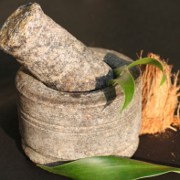 Photo: Getty Images
Photo: Getty Images
Dating back over 5,000 years, Ayurveda is one of the oldest forms of medicine in the world. However, the holistic health practice is far from remaining in ancient times. Ayurvedic medicine exists as complementary and alternative medicine (CAM) in the US, but according to the National Center for Complementary and Alternative Medicine (NCCAM), 80 percent of India’s people practice Ayurveda on its own or in addition to Western medical practices, and India has a total of 180 colleges teaching Ayurvedic medicine today.
Literally, the word Ayurveda means “science or knowledge of life” in Sanskrit. Ayurvedic medicine takes into account all aspects of life to create harmony among the mind, body and spirit. Once individuals are in complete harmony, they possess a strong well-being and are less likely to contract illnesses, leading to an overall longer and happier life.
The Five Elements
In Ayurveda, the entire universe is considered to be composed of five elements: earth, water, fire, air and space. Besides existing in the outside physical world, the five elements also exist and function as part of the human body. The five elements react outside and inside the body to create balance in the world.
Eattasteheal.com explains how although humans eat foods produced by the earth to survive, they ultimately become one with the earth after death. Making up almost 75 percent of the human body, water is necessary for life. Fire also supports human life because it warms the body and is produced during all chemical, inner-body procedures. While air is necessary to breath oxygen, it also causes all of the body’s actions due to its inner and outer body circulation. Lastly, space serves as the backbone and environment for the other four elements to interact and function.
Tridosha
The concept of life’s three energies or doshas (Tridosha) is another important idea of Ayurveda. Every dosha contains a combination of the five elements, and the energies control all actions on both the universal and physiological levels. According to NCCAM, when doshas become imbalanced, the body develops illnesses. “Imbalances may be caused by a person’s age, unhealthy lifestyle, or diet; too much or too little mental and physical exertion; the seasons; or inadequate protection from the weather, chemicals, or germs,” nccam.nih.gov said.
A total of three doshas (Vata dosha, Pitta dosha and Kapha dosha) exist, and a different combination of the doshas exists in all individuals. The elements space and air make up Vata. Of the three doshas, NCCAM says Vata is most powerful because it directs simple body functions like breathing, the mind and cell division. Vata can be dangerous if it is an individual’s primary dosha because the energy is linked to arthritis, heart issues, anxiety and neurological illnesses. Pitta is a combination of fire and water, and it controls hormones and digestion. If Pitta is the main dosha, individuals may be at risk of heart illnesses, hypertension, infectious diseases and digestion problems, NCCAM says. The third dosha, Kapha, is made of water and earth. Kapha helps strengthen the body against illnesses and deals with body growth and development. According to nccam.nih.gov, if Kapha is the principal dosha, the body may be prone to diseases including cancers, diabetes, obesity and breathing illnesses. For a full list of specific diets to follow for each dosha, visit the following links:
http://www.niam.com/pdf/Vata_Diet.pdf
http://www.niam.com/pdf/Pitta_Diet.pdf
http://www.niam.com/pdf/Kapha_Diet.pdf
In order to determine one’s main dosha and combination of doshas, Ayurveda practitioners ask the patient about their lifestyle (including diet, physical activity, daily activities, illnesses) and look at physical body features, NCCAM says.
Prakriti
All individuals possess unique inner and outer qualities. In Ayurvedic medicine, this concept is called prakriti. According to NCCAM, the distinct qualities of all humans are expressed in a “constitution” format, and that constitution remains the same throughout life. The National Institute of Ayurvedic Medicine (NIAM) explains that five components affect one’s prakriti:
1) The combination of one’s parents’ doshas during conception,
2) The parents’ plans and thoughts during conception,
3) Hereditary genes within the family,
4) The mother’s daily life, including diet, while pregnant, and
5) The state of the uterus during pregnancy.
Prakriti may constitute one’s overall balance in life, but it “will also determine to a great extent how one will develop the highest order of human qualities: love, compassion and pure consciousness,” NCCAM says.
Treatment
Ayurvedic medicine may apply various methods of treatment when tending to an illness and striving to maintain absolute balance. Common forms of treatment include herbal or plant remedies, yoga, massage, meditation, diet alteration, breathing exercises and stretching. NIAM explains that although multiple individuals may appear to have similar medical issues, they need different treatments due to their unique prakriti and doshas.
Resources:
http://nccam.nih.gov/health/ayurveda/introduction.htm
http://www.niam.com/index.php?option=com_content&view=article&id=61&Itemid=1
http://www.niam.com/index.php?option=com_content&view=article&id=62&Itemid=1
http://www.niam.com/index.php?option=com_content&view=article&id=63&Itemid=1
http://www.niam.com/index.php?option=com_content&view=article&id=68&Itemid=1
http://www.eattasteheal.com/Ayurveda101/ETH_5elements.htm
Reviewed August 4, 2011
by Michele Blacksberg R.N.
Edited by Jody Smith






Add a Comment5 Comments
It IS a science, more scientific than modern science! Here is a web site I use that has a lot of information: By the way in case your readers need to find their dosha, here is a test in a web site I sue a lot : http://www.naturesformulary.com/CategoryContents/Dosha-Test.aspx
August 24, 2011 - 11:03amThis Comment
Author please note: Ayurveda is more than 50,000 years old. It was first WRITTEN down 5,000 years ago,but the science was given out long before that.
August 5, 2011 - 6:20amThank you.
This Comment
Good informative article on ayurveda. Nice read for people unfamiliar with the science.
August 4, 2011 - 1:47pmThis Comment
Its not science.
August 4, 2011 - 2:34pmThis Comment
The Sanskrit word Ayurveda means "Science of Life".
August 5, 2011 - 2:01amThis Comment